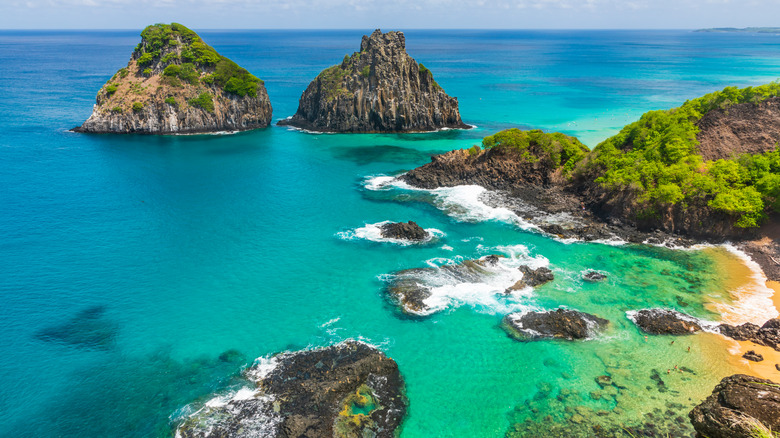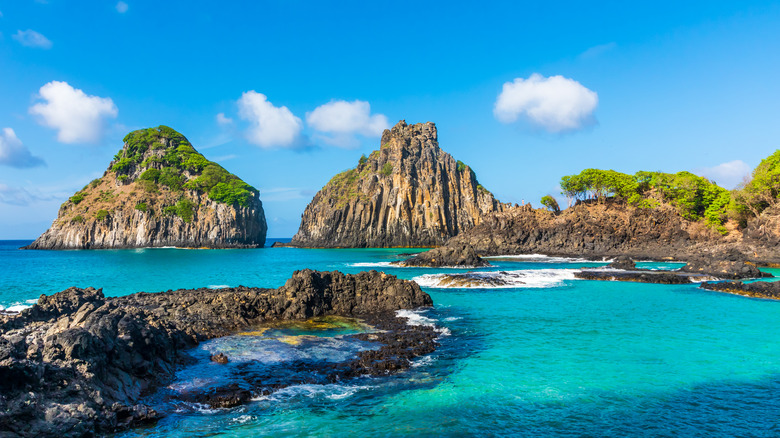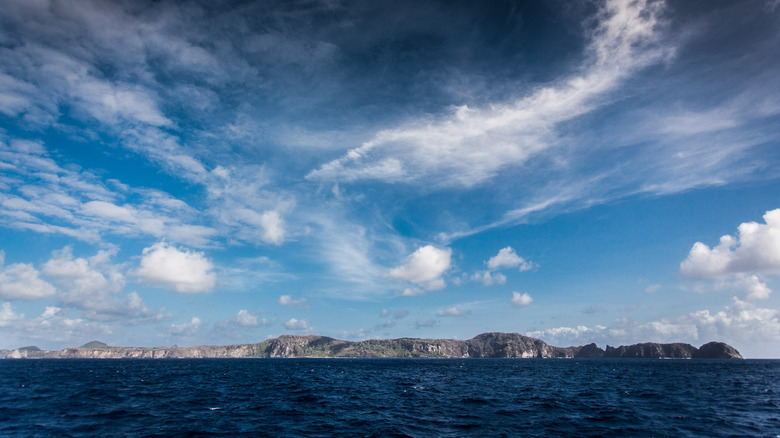Why Fernando De Noronha, Brazil Is The Perfect Destination During Cold-Weather Months
For all-around raw beauty, consider heading to the South Atlantic archipelago of Fernando de Noronha, located some 210 miles off the coast of Brazil. The collection of islands (along with the Atol das Rocas Reserves, about 90 miles west) was designated a UNESCO World Heritage Site in 2001. The area is comprised of volcanic peaks belonging to an underwater chain of mountains. Due to its unique topography, Fernando de Noronha and Atol das Rocas Reserves play a vital role in the environment. In the words of UNESCO, " ... [T]heir rich waters are extremely important for the breeding and feeding of tuna, shark, turtle and marine mammals. The islands are home to the largest concentration of tropical seabirds in the Western Atlantic."
Tourism is not allowed at the Atol das Rocas Biological Reserve, but travelers are permitted to visit Fernando de Noronha, which has attracted divers and other visitors the world over, including the famed naturalist Charles Darwin — a further testament to Fernando de Noronha's environmental legacy. However, the fact that more tourists have become aware of the main island of Fernando de Noronha has possible implications for the protection of the area. Fernando de Noronha's history as a penal colony and military base has had drastic effects on the environment, which is why it's important that tourists remain cognizant of their impacts on the region. Nonetheless, the biological community remains apparently stable, and there are strong management systems in place to preserve and enforce local regulations, specifically with regard to diving and fishing.
What to see
You can fly into Aeroporto Fernando de Noronha, and once there, it's easy to get around by bus, taxi, or even a dune buggy, which is available for hire or to rent. According to Nomadic Matt, just 500 people are allowed on the island of Fernando de Noronha at a time, and it's not cheap to go there. Still, the variety of activities is worth it. You can go hiking, kayaking, horseback riding, and watch dolphins. There's also a shark museum, and you can walk past the remains of Fernando de Noronha's military history. Another must-visit is Projeto Tamar, a local nonprofit that focuses on the conservation of turtles. Many attractions are located within the Fernando de Noronha Marine National Park, which covers 70% of the island and includes three of the area's best beaches, according to Lonely Planet. And of course, there is always an incredible sunset awaiting you at the end of each day.
When to go
The climate in Fernando de Noronha remains relatively stable throughout the year, ranging from 64 degrees to 90 degrees Fahrenheit, according to Nomadic Matt. April, he says, is the best time for diving, and you'll find better deals between May and August, given that it's the wet season. There's relatively less rainfall from August to December, which is when tourists are more prevalent. But as Nomadic Matt also points out, since the island allows no more than 500 people at a time, you'll never see big crowds.
Meanwhile, Travellers Worldwide says the most ideal time to see Brazil is between December and March. From the holiday season to Carnaval and beyond, there are many festivals taking place during this period on the mainland — along with other local celebrations. And, because December is mostly cool in the Northern Hemisphere, those who want to escape the encroaching chill above the equator would do best to come to Fernando de Noronha in the last month of the year. The temperature averages about 86 degrees Fahrenheit, and the climate is fairly sunny and dry. Plus, as Culture Trip points out, December kicks off surfing season at the island's Praia da Cacimba do Padre beach, so for anyone who loves to ride the waves (or just loves watching surfers do their thing), it's another reason to head to beautiful Fernando de Noronha in December.


